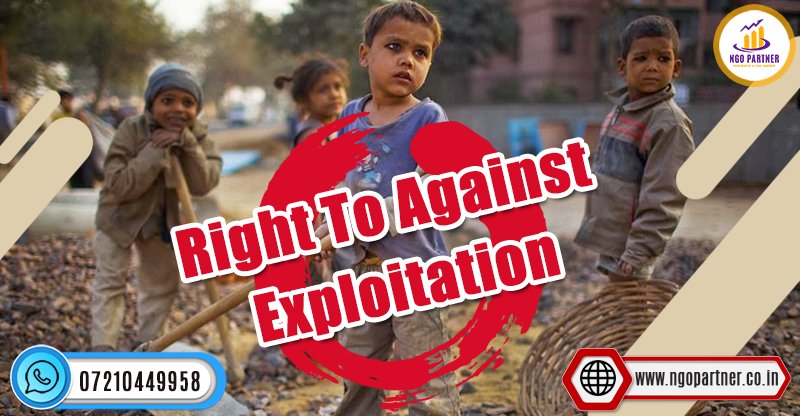
- June 14, 2023
- NGO Partner
- 0 Comments
- 849 Views
- 0 Likes
- Marketing Company Blogs
The Significance of the Right to Against Exploitation
The Right to Against Exploitation
In a world where exploitation continues to plague societies, the Right to Against Exploitation stands as a formidable shield, safeguarding the rights and dignity of individuals. Exploitation manifests in various forms, such as human trafficking, forced labor, and child labor, stripping individuals of their freedom and subjecting them to unimaginable suffering. It is crucial to recognize the prevalence of exploitation and acknowledge the urgent need for legal safeguards that protect the vulnerable and ensure justice prevails.

Across the globe, countless individuals, particularly the marginalized and disadvantaged, fall victim to exploitative practices. The Right to Against Exploitation serves as a beacon of hope, empowering individuals to break free from the shackles of exploitation and reclaim their autonomy. This fundamental right finds its roots in the Indian Constitution and is fortified by a robust legal framework that encompasses laws, acts, and international conventions.
In this blog post, we will explore the significance of the Right to Against Exploitation in combatting various forms of exploitation. From addressing human trafficking to eradicating child labor and preventing sexual exploitation, we will delve into the legal provisions, challenges faced, and future directions to ensure a society free from the clutches of exploitation. Join us on this journey as we unravel the importance of this crucial right in preserving human rights and fostering a more equitable and just world.
Definition and Scope of the Right to Against Exploitation
Unmasking the Right to Against Exploitation: A Guardian of Human Dignity
Deep within the fabric of the Indian Constitution lies the Right to Against Exploitation, an emblem of hope for the vulnerable and oppressed. This right serves as a potent weapon against the insidious perpetrators of exploitation, encompassing a wide range of injustices that plague our society. From the dark underbelly of human trafficking to the chains of forced labor and the tragedy of child labor, this constitutional shield defends individuals from the clutches of exploitation, restoring their dignity and granting them the freedom they deserve.
Forms of Exploitation: Unveiling the Unseen Chains
Within the realm of the Right to Against Exploitation, various forms of exploitation find themselves exposed under the glaring light of justice. The sinister world of human trafficking, where lives are bartered and innocence is stolen, stands in stark contrast to the ideal of a just society. Forced labor, a cruel master that coerces individuals into a life of servitude, echoes the injustices of the past. And the haunting reality of child labor, where the dreams of the young are crushed under the weight of laborious burdens, begs for our attention. It is within these realms that the Right to Against Exploitation comes alive, combatting these forms of exploitation and striving for a society that values and cherishes every individual.
Legal Framework
The Indian Tapestry of Justice: Constitutional Provisions and International Commitments
The Right to Against Exploitation finds its strength not only in the Indian Constitution but also in a web of laws, acts, and international conventions woven to protect the vulnerable. From the hallowed pages of the Constitution to the global arena, a comprehensive legal framework has been established to address exploitation. Constitutional provisions such as Article 23 provide the bedrock of protection, while legislations and acts like the Immoral Traffic (Prevention) Act and the Bonded Labor System (Abolition) Act serve as potent weapons in the fight against exploitation. Furthermore, India’s commitment to international conventions, such as the Palermo Protocol and the International Labor Organization conventions, demonstrates its dedication to eradicating exploitation on a global scale.
Guardians of Justice: Legislations and Support Systems
Delving into the realm of specific legislations, we witness the power of the Immoral Traffic (Prevention) Act, which cracks down on the heinous crime of trafficking and seeks to rescue and rehabilitate victims. The Bonded Labor System (Abolition) Act stands as a guardian against the chains of forced labor, breaking the cycle of oppression and granting freedom to those ensnared. Alongside these legislations, law enforcement agencies work tirelessly to dismantle exploitative networks, while rehabilitation measures and support systems provide solace and assistance to survivors, helping them rebuild their lives.
The fight against exploitation requires an unwavering commitment from society as a whole. Together, let us explore the depths of the Right to Against Exploitation and advocate for a world where every individual is free from the clutches of exploitation, where dignity and justice reign supreme.
Child Labor Eradication
Unmasking the Chains: Liberating Childhood
Within the realm of the Right to Against Exploitation, a particular battleground emerges—one where innocent smiles are stolen and childhoods are shattered. Child labor, a stain on society’s conscience, finds itself in the crosshairs of the Child Labor (Prohibition and Regulation) Act and a tapestry of government schemes. These legal provisions strive to eradicate this abhorrent practice, ensuring that children are not robbed of their right to education, play, and a promising future. By unraveling the complexities of child labor and bolstering enforcement, we can pave the way for a society where the vibrant hues of childhood shine bright, untainted by exploitation.
Illuminating Pathways: Education, Awareness, and Enforcement
In the fight against child labor, education becomes a beacon of hope—a powerful tool to break the chains of intergenerational exploitation. By imparting knowledge and fostering awareness, we equip children with the armor of education, empowering them to forge a different destiny. Additionally, robust enforcement mechanisms are crucial to dismantle the networks that perpetuate child labor. It is through the collective effort of policymakers, law enforcement agencies, and grassroots organizations that we can ensure the effective implementation of child labor laws. By uniting these pillars of change, we illuminate the pathways toward a society that cherishes the rights and well-being of its youngest members.
Preventing Sexual Exploitation
Shielding the Innocent: A Battle against Darkness
Sexual exploitation, a despicable crime that preys upon the most vulnerable, demands our unwavering attention. The Protection of Children from Sexual Offences Act stands tall as a bastion of protection, shielding the innocent from the clutches of abuse. Initiatives targeting commercial sexual exploitation amplify our collective voice against this heinous crime. Through awareness campaigns, we peel back the layers of secrecy, exposing the hidden truths and educating communities on the signs and consequences of sexual exploitation. Rehabilitation programs and victim support services extend a lifeline to survivors, offering solace, healing, and pathways to rebuild their lives. Together, we forge a society where the shadows of exploitation fade, replaced by a radiant dawn of empowerment and protection.
Challenges and Future Directions
Unveiling the Shadows: Confronting Challenges
In the quest to fully realize the Right to Against Exploitation, we must confront the shadows that hinder progress. Lack of awareness poses a formidable challenge, as many remain unaware of their rights or the extent of exploitation that exists. Weak implementation of laws allows exploitation to persist, leaving vulnerable individuals without adequate protection. Social stigma further exacerbates the issue, silencing victims and perpetuating a cycle of suffering. However, by shining a light on these challenges, we take the first step toward overcoming them.
Illuminating the Path: Toward a Society Free from Exploitation
To create a society free from exploitation, we must adopt a multi-faceted approach. Strengthening awareness campaigns and educational initiatives can enlighten individuals about their rights and foster a culture of intolerance toward exploitation. Robust enforcement measures and stringent penalties can act as deterrents, ensuring that perpetrators face the consequences of their actions. Additionally, providing comprehensive support services to survivors, including counseling, rehabilitation, and skill development programs, is essential for their healing and reintegration. By collectively addressing these challenges and embracing a shared vision of a just and compassionate society, we pave the way for a future where exploitation is but a distant memory.
In conclusion, we have traversed the landscape of the Right to Against Exploitation, a formidable shield against the pervasive darkness of exploitation. We have explored its various dimensions, from combating child labor and preventing sexual exploitation to addressing the challenges that impede progress. The significance of this right in safeguarding individuals’ rights and dignity cannot be overstated. Let us carry the torch of awareness, empathy, and action, standing united in our resolve to eradicate exploitation from our societies. Together, we can create a future where every person is free from the shackles of exploitation, their rights upheld and their dignity protected.




Leave a Comment